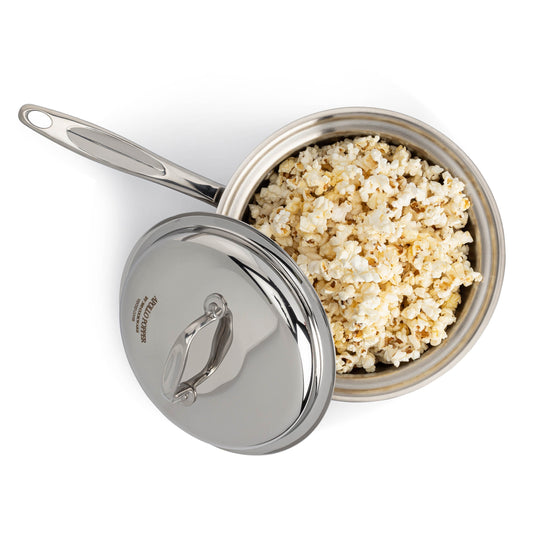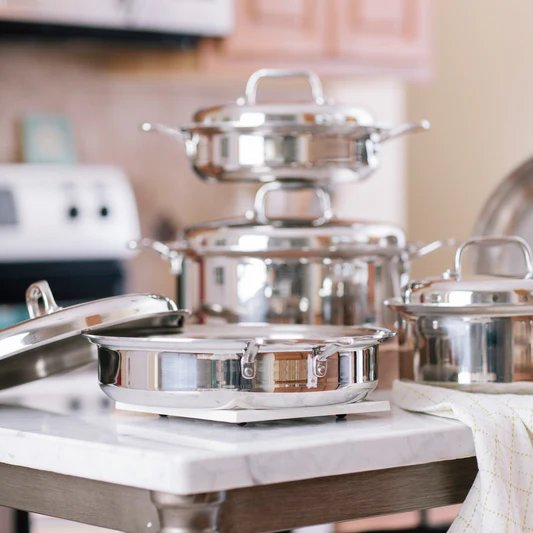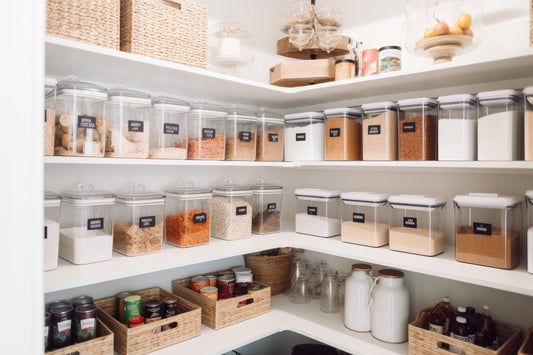While it’s not likely to be the first purchase that you make when outfitting your kitchen, a stainless steel jelly roll pan is a versatile addition to your baking equipment collection. Let’s look at what makes this pan so useful for home cooks.
What is a Jelly Roll Pan?
As the name implies, a jelly roll pan is primarily designed to be used for preparing jelly rolls, a classic style of cake that is making something of a comeback, if Instagram is anything to judge by! Jelly rolls may or may not contain jelly, but their main claim to fame is that they have almost as much icing or filling as cake, making for a truly decadent dessert.
A jelly roll pan has raised sides about an inch high, allowing for the thin layer of cake batter to rise without overflowing the pan. Jelly roll recipes are developed for this specific size of pan.
How Big is a Jelly Roll Pan?
A jelly roll pan is a distinct size compared to standard quarter and half sheet pans, although they are similar in appearance. Whereas a half-sheet pan is 18x13 inches, and a quarter-sheet pan is 13x9 inches, a jelly roll pan is 15x10 inches.
Jelly Roll Pan vs Cookie Sheet
A cookie sheet may seem like a practical alternative to a jelly roll pan, but the two types of bakeware are not easily interchangeable. While a jelly roll pan has inch-high sides to contain a runny batter, cookie sheets don’t have raised edges. Without sides, the cookies bake more evenly, and it’s easier to slide the baked cookies off without breaking them.
However, while you can’t bake a jelly roll layer on a cookie sheet, in a pinch you can use a jelly roll pan to cook up a small batch of cookies.
Jelly Roll Pan vs Sheet Pan
Sheet pans have become ubiquitous in the modern kitchen, where they’re used for roasting meats and vegetables. But if you don’t want to invest in a whole set of bakeware, one jelly roll pan is the most versatile choice.
While the jelly roll pan is between a half-sheet and quarter-sheet in size, for recipes that don’t require a specific dimension, such as roasted chicken legs and assorted vegetables, the jelly roll pan can be used as a substitute.
On the other hand, because jelly roll recipes are intended for the exact dimensions of a jelly roll pan, it’s not as easy to use a sheet pan instead. If you can only buy one pan, the jelly roll pan is a better choice.
Uses for a Jelly Roll Pan in Your Kitchen
The most obvious use for a jelly roll pan is, of course, preparing a jelly roll. The cake batter is spread over the surface of the pan in a thin, even layer. It’s usually recommended to first lay down a sheet of parchment paper to make it easy to remove the cake from the pan after it’s been baked.

However, a jelly roll pan can be used for other purposes as well! It’s perfect for:
- brownies or cookie bars
- oven-roasted vegetables
- oven-roasted chicken breasts
- bacon
- toasted nuts
- oven fries
- nachos
- deep-dish pizza
Best Materials for a Jelly Roll Pan
As with all pots and pans, jelly roll pans are available in various materials. Let’s look at your choices.
Nonstick
Nonstick bakeware is most commonly made of aluminum, with a coating of a nonstick material, usually PFOA-free Teflon. The slick surface prevents food from sticking to the pan. That may sound ideal, but there are drawbacks to nonstick pans. While newer coatings are advertised as non-toxic, there’s still a risk that a scratched or abraded nonstick surface could lead to contamination of whatever you’re cooking. Additionally, nonstick pans are not recommended for use at the high temperatures usually used for sheet pan roasting techniques.
Nonstick cookware and bakeware also have a short lifespan, as even normal use will end up degrading the coating, and you will have the expense of buying replacements every few years.
Ceramic
Ceramic is the new nonstick favorite, featuring a slick coating created by fusing a layer of silicon dioxide to the inner surface. As with regular nonstick pans, over time the coating will become worn or chipped, leading to the risk of particles ending up in your food, and they will need to be replaced within a few years.
Read the benefits of Stainless Steel over Ceramic Cookware
Aluminum
Aluminum has long been used for manufacturing pots and pans, as it conducts heat well and is relatively lightweight. However, there are drawbacks to using bakeware made from aluminum. There has been some research linking exposure to aluminum to an increased incidence of Alzheimer’s disease.
Stainless Steel
A quality stainless steel jelly roll pan is a safe and versatile addition to your kitchen equipment, and one that will last a lifetime! The 360 Cookware jelly roll pan has inner and outer layers of surgical grade stainless steel bonded to a core layer of aluminum. This way, you get the advantage of excellent heat distribution from the aluminum, while at the same time your food will only come in contact with the stainless steel surface, preventing any possibility of exposure to the potential harms of aluminum.
Time To Roll
Whether you’re looking for a general purpose sheet pan, or want a pan specifically designed for jelly rolls, a stainless steel jelly roll pan is the safest and most versatile choice for the home kitchen.





